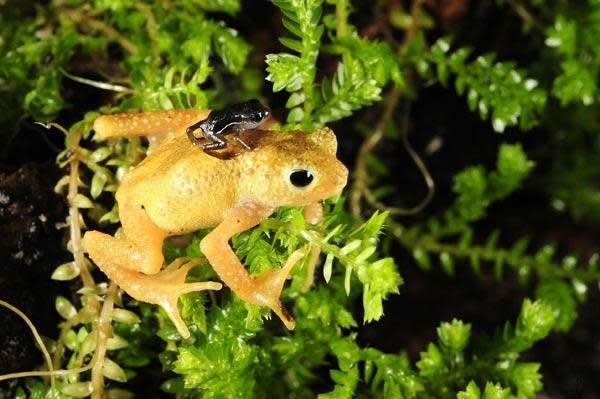Once-Extinct Toads Reintroduced to Wild
A tiny, vanished toad has returned home.
About 2,000 Kihansi spray toads have been reintroduced into the Kihansi Gorge in Tanzania after the animal was declared extinct in the wild. This is the first example of an amphibian species that had been declared extinct in the wild being repatriated to its native habitat, according to a release from the Wildlife Conservation Society (WCS), an environmental group which has led the effort to return the toads to their home.
The Kihansi spray toad is gold-colored, with pale white, almost translucent skin on its abdomen that makes its intestines visible. The toad belongs to a unique group of amphibians that give birth to live young in lieu laying eggs weighs. After delivering their young, the toads carry the babies on their backs.
In 1996, a population of the tiny toads was first found living near the bottom of a waterfall in the Kihansi Gorge, where spray from the pounding of water on rock created a unique micro-habitat in which the animals thrived.
Discovered, disappeared
The animals were discovered in the beginning of the construction of a hydroelectric dam on the river that now supplies Tanzania with one-fourth of its energy, according to the release. But the dam severely reduced the amount of spray from the waterfall and the toad's numbers quickly declined. In an effort to conserve them, 500 of the animals were moved to New York's Bronx Zoo. But their numbers continued to dwindle in Tanzania until they were declared extinct in the wild in 2009.
Some of the Bronx Zoo toads were transferred to the Toledo Zoo in Ohio, where researchers were able to sustain about 50 of the toads. Soon, the toads were reproducing in the lab and their captive population rebounded.
In 2010, about 100 of the toads were flown to a propagation center in Dar es Salaam, Tanzania's commercial capital and largest city. They bred and multiplied until there were enough to safely return them to the wild, according to the release.
Return to the wild
"The reintroduction of the Kihansi spray toad to the Kihansi Gorge is a momentous achievement in conservation," said Cristián Samper, WCS president, in the statement. "This has been a truly global effort to save a species. This project proves that through partnership and science — wildlife can prevail." [Ten Species Success Stories]
An artificial system of sprinklers has been set up by the Tanzanian government and the World Bank to recreate the spray from the waterfall, according to the release.
The Bronx and the Toledo zoos will continue to maintain what is called an "assurance population" of the spray toads and have them on exhibit for visitors to see. The released toads and their habitat will be closely monitored to ensure that environmental conditions remain favorable and to keep tabs on the progress of the animals.
The ultimate cause of extinction of this species in the wild is still being debate. But scientists hypothesize that a combination of habitat change, pesticide exposure and the emergence of infective chytrid fungus led to their demise. Chytrid is responsible for alarming declines and extinctions of amphibian species throughout the planet.
Reach Douglas Main at dmain@techmedianetwork.com. Follow him on Twitter @Douglas_Main. Follow OurAmazingPlanet on Twitter @OAPlanet. We're also on Facebook and Google+.
Copyright 2012 OurAmazingPlanet, a TechMediaNetwork company. All rights reserved. This material may not be published, broadcast, rewritten or redistributed.




